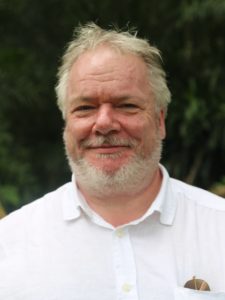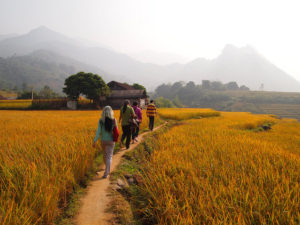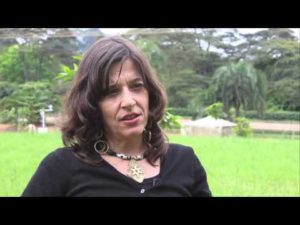 By Fergus Sinclair, Systems Science Leader, World Agroforestry Centre (ICRAF) and Flagship Coordinator Livelihood systems, CGIAR Research Program on Forests, Trees and Agroforestry
By Fergus Sinclair, Systems Science Leader, World Agroforestry Centre (ICRAF) and Flagship Coordinator Livelihood systems, CGIAR Research Program on Forests, Trees and Agroforestry
We have three main types of partnerships in the livelihood systems flagship – those with donors, those with upstream research providers and those with the users of our research outputs – the organizations that implement development, including national systems and nongovernmental organizations (NGOs).
Partnerships with the private sector cut across these types as they may involve funding, collaboration in cutting-edge science and the use of research outputs.
Funding partners
Let’s start by looking at our long-term funding relationships, where we work in tandem with donors to develop and implement strategic research. Good examples of this are with IFAD (United Nations International Fund for Agricultural Development) and ACIAR (Australian Centre for International Agricultural Research). They fund a number of our activities.
ACIAR, for example, fund FTA work on trees for food security in East Africa, value chain innovation platforms in Southern Africa and market-based agroforestry for livelihood enhancement in both Vietnam and Indonesia. There is a lot of cross-fertilization among these projects including sharing of experience, methods and tools.
Also read our first partnerships blog: From competition to collaboration: Partnerships make forests, trees and agroforestry program work
We work in discussion with the donors to develop a research agenda that meets their needs. Influence flows both ways – we suggest key innovations that we think can address the development challenges that they want to tackle and accumulate experience as innovation proceeds, while they evaluate our ideas, how their projects are performing and the impacts that they make once they are underway.
Working closely with donors is key; it helps to ensure that our research is making the sort of impact on food security and poverty reduction that donors want to see. With IFAD, the relationship goes further, because they want their research funding complementing their loans to governments in the countries where we work.
So, for example, we have a research project on land restoration with sites in Ethiopia, Kenya, Mali and Niger. The research funding for Kenya is about USD 1 million but it supports the Kenya Cereal Enhancement Program (KCEP) loan and a grant program to the Kenyan Government, which represents an investment of USD 118 million to increase productivity and climate resilience amongst smallholder farmers across eight semiarid counties.

This allows us to embed our research in development, making it possible to research how options to increase land productivity need to be locally adapted to the fine-scale variation in context. This co-learning with development partners, about what options work where and for whom, accelerates development impact while increasing our fundamental understanding of how contextual variables condition the suitability of options – creating international public goods in terms of knowledge that can applied beyond the contexts it was created in.
Many donors are incentivizing centers working together through the FTA partnership by requiring projects to justify their contribution to the CGIAR research programs. GIZ (Gesellschaft für Internationale Zusammenarbeit), IFAD and ACIAR all require this and they often favor proposals that involve more than one of the core partners in FTA.
Our latest IFAD-funded project, for example, is a joint research project with the Center for International Forestry Research (CIFOR), where we team up with Tree Aid to investigate how to improve the management of the forest-farm interface in Burkina Faso and Ghana.
Implementing partners
We also have important partnerships with development NGOs who take up FTA research outputs and use them in practice. A key issue over the last few years has been developing methods and tools that development partners can use to promote tree diversity.
Often, tree planting programs have promoted a few exotic tree species in prescriptive management regimes, such as woodlots but there is potential to use a much broader range of species in many different field, farm and landscape niches that are more inclusive in terms of benefit flows to different groups of people.
We have worked closely with WWF (the World Wide Fund for Nature) in both the Lake Tanganyika catchment area and around Virunga National Park in the Democratic Republic of Congo (DRC) to do just this – and it has worked, because we have not only got the science right, but also delivered it to practitioners in ways that they can readily use it. The result is that livelihoods and landscapes become more resilient through combining high-end science (e.g. image analysis of erosion hotspots) with local knowledge (e.g. about compatibility of different tree species with agricultural practice).
It is a common fallacy that getting closer to farmers and the reality of implementing development leads to more applied science rather than fundamental research. Nothing could be further from the truth.

Research partnerships
Working with development partners and farmers often throws up fundamental research challenges and we have important upstream research partnerships to tackle them. We have selected upstream partners who have key expertise in strategic areas where we need to make fundamental advances.
We work with Bangor University in the UK because of their gene sequencing research on soil biota. This is helping us to develop approaches to understanding the functional profiles of soil organisms so that we can see how trees can be used to maintain soil health on agricultural land.
This is a huge issue in Africa where it has been estimated that around 30% of soils are now non-responsive – i.e. crop yield does not increase even if fertilizer is applied because the soil function is impaired.
Trees are associated with a higher abundance and more activity of beneficial soil organisms but we need to know more about what tree species and management practices are required to restore function in different soils.
With the Commonwealth Scientific and Industrial Research Organisation (CSIRO), we have a strategic partnership on the development of the agricultural production systems simulator (APSIM) to handle tree-crop interactions. APSIM is a family of globally calibrated crop models, so once we are able to add trees to the mix we can predict the impacts of changing tree cover on food security globally – including looking at the implications of agroforestry using the International Food Policy Institute (IFPRI)’s IMPACT model (The International Model for Policy Analysis of Agricultural Commodities and Trade).
Currently, agroforestry doesn’t get any kind of evaluation in these global studies because they can’t incorporate it into the framework. So by developing APSIM to include trees we can give agroforestry much greater prominence through producing credible predictions of the impacts of trees on food security and compare it with other interventions.
In FTA phase one we have developed the capacity to model a few tree species and crops in APSIM; in phase two we will extend this to embrace tree diversity for a wide range of cropping options.

Our partnerships with universities across Africa, Asia and Latin America are very enriching. For example we have a network of African universities with whom we work to develop a curriculum of modern agroforestry programs, associated with the trees for food security program in Ethiopia, Rwanda and Uganda.
We also have a strong relationship with Jomo Kenyatta University of Agriculture and Technology in Kenya, including a long-term agroforestry trial, which they set up with our assistance.
We’ve had a lot of success in our research on cocoa productivity, funded through the Mars Vision for Change initiative in Cote d’Ivoire – that produces 40% of world supply. Research collating scientific understanding and acquiring farmers’ knowledge and perceptions about companion trees in cocoa has shifted. What was initially a concentration on full sun systems has led to the development of a national agroforestry strategy that focuses on sustainable intensification by incorporating trees in cocoa fields.
This has involved changes in attitudes in both government and the private sector; it is an ongoing process with people in the same institutions often pulling in different directions, which create challenges for maintaining effective partnerships.
Lessons learned
Designing effective partnerships is not always straightforward. Our cooperation with CIMMYT, the International Maize and Wheat Improvement Center for example began with small subcontracts between us for specific work.
So in FTA we subcontracted CIMMYT to do specific research on productivity of crops under trees in Ethiopia and Rwanda, as part of our ACIAR-funded trees for food security initiative. Although they produced exciting results showing higher wheat yields under trees, we realized that a series of small contracts with high transaction costs was not the best way to advance our understanding of tree-crop interactions – what we needed was large, genuinely joint funding to facilitate development of joined-up research combining expertise across the forest and agricultural divide.
In the second phase of FTA, we will seek to obtain major joint funding on tree-crop interactions with CIMMYT rather than operating through small, piecemeal subcontracts from grants focusing on either the tree or the crop.
In our flagship proposal for Phase II we have a section on managing partnerships, which deals with the risks of partnerships failing and the strategies we have in place in order to mitigate those risks. We engage in partnerships that we think will work; we make sure we have a range of partners, so that we do not have all our eggs in one basket; and we use various means such as reflection cycles, coupled with flexibility to adjust partnership modalities, to try and sustain and strengthen partnerships as our research agenda unfolds.











